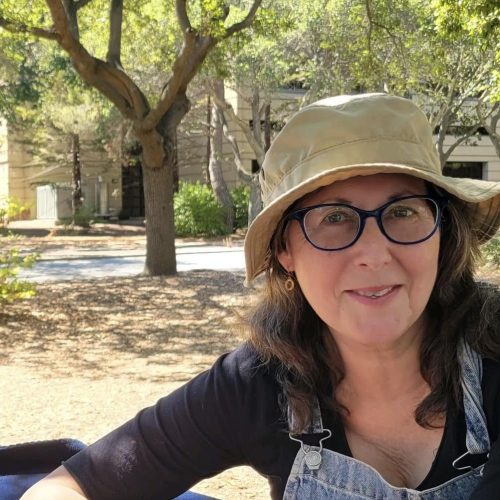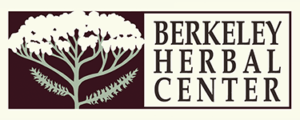
Every month, we get to spotlight a past student of the Berkeley Herbal Center Herbal Certifications Courses. This month we caught up with Christine Holland!
Christine is based in Menlo Park, California about 40 miles away from BHC. She found her way to herbalism through a lifelong connection to nature that led to being called to work with healing plants. She completed our full four-year program of Foundations, Therapeutics, and then first and second year clinic, in 2022.
This is her story.
One of my first memories is of a plant. I was maybe four years old, squatting in our back yard in Poughkeepsie New York, entranced by a tiny sprout that had popped up under a leaky spigot there. It shone brilliant green, and I was full of joy as I looked at it. I’m pretty sure we were communicating but I don’t remember what was said.
That house was in a suburban area surrounded by woods full of maple trees, jack-in-the-pulpit plants, robins and their nests holding tiny bright blue eggs. I spent plenty of hours communing with the forest, daydreaming, lost in the scents and sounds of that wild place. Our house was less than a mile from the Hudson River, and you could hear it flowing in the spring.
My family moved to Northern California when I was seven. Our new home was in what is now known as Silicon Valley, but when we arrived it wasn’t fully the high-tech mecca it is today. We got there during a time of transformation, when Silicon Valley supplanted what used to be known worldwide as “The Valley of Heart’s Delight,” a land full of orchards bearing apricots, cherries, nectarines, peaches, and plums.
There was an abandoned apricot orchard across the street from our new-built house, where I played under the bright-white blossoming trees until a year or so later when bulldozers knocked them all down to make room for another tract of ranch houses. Over those first few years we lived in California, I watched as one by one the orchards, whose flowers used to light up the whole valley everywhere you went in spring, succumbed to the bulldozers and were replaced by houses and office parks, shopping malls and parking lots. It made a big impression on me, this “progress” – it didn’t feel like progress, it felt like desecration.
It left me with big doubts about the way our species behaves toward our mother planet, doubts that only grew larger as I got older, went to college, started working in high-tech companies. It didn’t feel like I was on the right path. I wanted to reclaim what the sprouting weeds, the jack-in-the-pulpit, the shade under the maples told me. To understand what wounds had scarred me, when the bulldozers plowed under the apricots and it felt as if they were plowing my body too. What words they gave me to speak.
I have to skip over a lot of years here. I spent way too long afraid to leave my well-paid work as a marketing director – a failure of imagination and courage. But during those years I married and we bought a ranch near Mt. Shasta, where we raised sheep with the help of nine dogs to herd and guard the flock. I studied botany and garden design, then studied to be a Certified California Naturalist. I spent time in wild places, learning how to connect (or re-connect) with nature, how to introduce myself to the land and the plant-beings rooted there, how to create ceremonies to honor and celebrate their existence and the gifts they offer.
And I wrote poems – poems to honor the earth, to celebrate all her beings, poems about my grief for the planet. Poetry kept me connected to the dreaming of the earth as I carried on with my unhappy career and my unhappy marriage and felt more and more like the life I was living wasn’t really mine. My life was meant to be something different.
Finally, finally, I began to hear that whisper, that calling to work with the plants for my own healing, and more: curiosity and hope that maybe, just maybe, this was the path back into grace I felt in the presence of that tiny green plant in my back yard in Poughkeepsie, New York.
I think “herbalism” as a career, a calling, wasn’t ever on my radar until suddenly it was. I found Berkeley Herbal Center on the web, signed up for a short-course evening class just to see what it might feel like. From the minute I walked into that room where the teacher was serving tea made from roses and holy basil, I knew I was where I should be. I wanted more of this.
Jump forward to a year later, and I’ve started the Foundations course at Berkeley Herbal Center. I loved the whole experience. I felt guided by my teachers, by the plants, by the spirit of the center itself. I loved my class, a group of passionate, funny, creative, magical individuals who bonded tightly as the year went on. We supported each other and had so much fun together, learning and growing into our individual medicine spirits. I even enjoyed doing the monographs, not only because it was fascinating to dive into the Materia Medica of Western Herbalism, but also because I knew I was creating a resource for my future work as a healer. There was always something new to learn, and there always will be. Herbalism is never boring.
In Therapeutics we started to learn how to formulate – to combine herbs into formulas to help clients come into physical, emotional and spiritual balance. We worked with the case studies of former clients who had given BHC permission to use their stories. It was fascinating to see how my classmates and I approached each case – usually there were some things in common but then there were big differences too. It showed me that there’s no one “right” way to practice plant medicine, and many paths to healing for every individual. Again, it was always fascinating, and it made me eager to start working with people in person.
I went through both the first- and second-year clinic internships at BHC. The first year was intense. I saw clients with a range of problems and was challenged each time to learn more, to go deeper, to grow as a healer. It was a continuation of the Therapeutics experience but this time with living people. I worked with my fellow clinicians and our supervisors to come up with creative, supportive recommendations, then revised or added to them over the course of time depending on how the client responded. In the second year, the training wheels were off and I was free to see clients on my own as I began my own practice, still with continuing education and mentorship from Pam.
I took on the work of assistant to the BHC executive director during my first clinic year, and I’m still in that position. The job means I’m really connected to BHC and the people there, and I love being part of making the center run so it’s always there for the students, faculty and community.
In my own work, I’m envisioning a kind of center for my own community. As mentioned, I live about 40 miles from BHC in Menlo Park, which is something of an “herbal desert” – there are no schools, no classes, no herb shops, and very few herbalists. I feel called to remedy this situation in my own neighborhood, so I’m setting up my back yard garden and office space to hold “Open House” events for my neighbors starting in the spring. I want to offer them a place and time to come into the garden, to introduce them to the plants and vice versa. Meanwhile, I’m working with a few clients, gaining experience and continuing my own herbal education with classes both at BHC and online.
Poetry continues to be a central part of my life and has become more and more important to my work as an herbalist. When I work with someone, I open my heart and mind to the plants that want to support them. This process leads to words, a poem – a poem for my client, a healing incantation. These words seem to come out of a higher vibrational level that shows up for everyone differently, maybe as dreams or visions, as music or even tastes, scents, physical sensations. It feels good to weave this thread, this lifelong part of myself, into my herbal practice. It tells me I’m moving in the right direction.
Herbalists believe digestive health is the foundation of overall health, and fermented foods are a wonderful way to support our gut bacteria and keep our digestive systems in good shape.
To that end, I often recommend beet kvass to my clients with digestive issues. Beet kvass is a traditional fermented drink that contains Lactobacillus bacteria, gut-friendly probiotics that happen to be salt-tolerant. The salt used in this lacto-fermentation process kills harmful bacteria while allowing the Lactobacillus bacteria to thrive.
Lacto-fermentation is a very traditional way to preserve food while improving its probiotic and enzyme content. Beet kvass has many other health benefits besides giving a probiotic boost. It also offers a generous dose of antioxidants, vitamins and minerals, and beets contain naturally-occurring nitrates that your body converts to nitric oxide. This substance helps your blood vessels dilate and improves circulation and oxygenation throughout your body. As a result, drinking beet kvass regularly can help reduce blood pressure and may enhance cognitive functioning as you age.
I find it delicious, only faintly beet-tasting, slightly sour, slightly salty, full of umami. You can sometimes find kvass at farmer’s markets, but homemade kvass is dead simple and only requires four ingredients: beets, spring water, salt, and time. My recipe is adapted from Stephanie Gaudreau’s recipe, here.
½ – ¾ lb organic red beets
2-3 teaspoons sea salt
Filtered or spring water
1 quart mason jar
Select organic beets if possible. Gently wash your beets with water, no soap, but don’t peel them. (The probiotic bacteria live on the beet skin.) Cut them into ½ – ¾” cubes, and put them in a 1 quart Mason jar. Do not grate the beets. They’ll ferment too fast and become alcoholic.
Add sea salt – up to a tablespoon per quart. This helps prevent harmful bacteria from taking over. I prefer coarse Celtic grey sea salt, but Himalayan pink salt or any other natural salt will do – just do NOT use iodized salt.
Fill the jar with filtered or spring water, put the lid on, and let it sit at room temperature for 3-4 or up to 5 days. It will change color from translucent pink to a dark, opaque red. Stir it occasionally and taste it – the flavor will change and deepen as it ferments and eventually it will be ever-so-slightly fizzy. It’s ready to drink now, but it gets even better if you put it into the fridge and let it continue to brew for 2-3 more days. If you notice some white foamy stuff forming on top of your kvass, you can scrape it off although it’s nothing to worry about, just part of the fermentation process.
Strain out the beets and drink 4-6 oz every day. Will keep for at least a week in the refrigerator.
Support Our Work
Berkeley Herbal Center is a 501(c)(3) organization, so all donations are tax deductible. Tax ID #14-1975183
If you would like to donate by check or cash, please send an envelope addressed to:
Berkeley Herbal Center
1250 Addison St., #G
Berkeley, CA 94702
